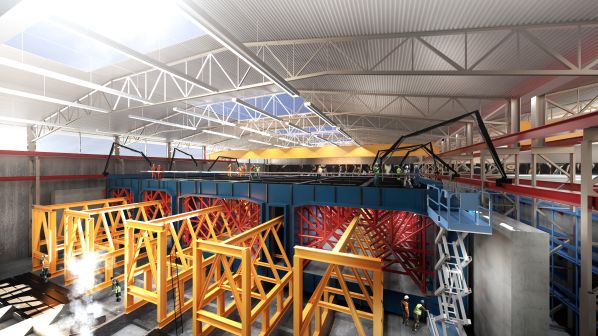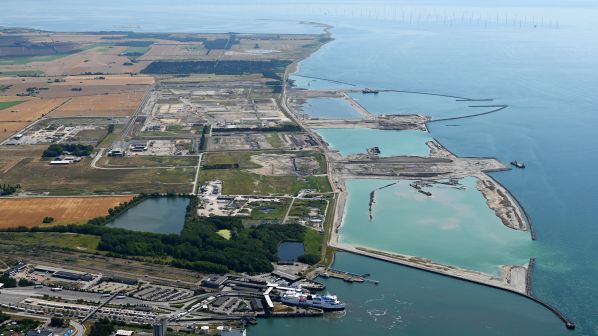FOLLOWING years of planning, approvals and tendering, work has begun on the 18km Fehmarnbelt road and rail tunnel between the islands of Lolland in Denmark and Fehmarn in Germany, which when completed in 2029 will be the longest immersed tunnel in the world. The tunnel will provide a more direct route between Copenhagen and Hamburg, and from Scandinavia to mainland Europe, by removing the need to travel west via the island of Funen to Fredericia on Jutland and then south to Padborg on the German border.
The tunnel will be constructed by digging a trench along the sea floor, before large prefabricated concrete sections are floated out and lowered into place. Cut and cover tunnels will be built at both ends to connect the tunnel to the portals. The tunnel will have capacity for up to 70 freight and 38 passenger trains a day.
Construction of the tunnel was authorised by the signing of a state treaty between Denmark and Germany as long ago as December 2008. Under this agreement, Denmark is the sole owner and will bear the full risk of financing the construction of the tunnel, as well as for upgrading the Danish hinterland road and rail connections. The link was approved in Denmark through the Danish Parliament’s adoption of the Construction Act in 2015, while final approvals in Germany were granted in January 2019. Two public undertakings have been entrusted with the planning, construction and operation of the project in Denmark: Femern Landanlæg for the Danish hinterland connections and Femern for the coast-to-coast infrastructure.
The overall cost of the project is budgeted at DKr 55.1bn ($US 8.6bn) at 2015 prices. This will be funded through state-backed sovereign loans, which will be repaid through tunnel access charges over 28 years. The same type of financing model will also fund the DKr 9.5bn project to rebuild the 115km Ringsted - Holeby line as part of the Danish hinterland upgrade.
Contracts awarded
Femern awarded four major construction contracts worth almost DKr 30bn to two consortia in March 2016. Femern Link Contractors (FLC) was awarded three of the contracts for the north and south tunnel portals and ramps sections of the link. FLC comprises Vinci Construction Grands Projects, and Soletanche Bachy International, France, Per Aarsleff Holding, Denmark, Wayss & Freytag Ingenieurbau and Max Bögl Stiftung, Germany, CFE and Netherlands Dredging International, Belgium, and BAM Infra and BAM International, Netherlands.
The dredging and land reclamation contract was awarded to Fehmarn Belt Contractors (FBC) comprising Boskalis International and Van Oord Dredging and Marine Contractors, Netherlands.
In February 2020, Femern appointed SNC Lavalin subsidiary Atkins to provide railway technical consultancy services for the project. Atkins will deliver multidisciplinary railway consultancy services throughout the project, which will include the track, overhead catenary, power supply, signalling, train control system and telecommunications. Atkins will also collaborate with German engineering firm Gauff, which will focus on the German elements of the new railway.
The tunnel and hinterland connection will have a major effect on long-distance trains travelling from Scandinavia to Germany and central Europe, reducing Copenhagen - Hamburg travel times from 4h 30min down to around 2h 30min.
Femern contract director, Ms Kirsten Margrethe Christensen, says awarding these contracts while the approvals process was ongoing meant work could begin as soon as they were obtained. The first step in the implementation phase was the construction of the large harbour to take delivery of the huge quantities of sand, cement, steel and gravel required to cast the tunnel sections. The tunnel factory built behind the harbour will manufacture the 79 217m-long standard concrete sections that will be used to construct the tunnel, and 10 special sections with a lower floor to hold the tunnel operation and maintenance equipment.
The sections weigh 73,000 tonnes and contain two tubes for the motorway, two for the railway and one for the central service passage. The sections will be immersed in a 12m-deep trench dredged on the seabed at a depth of up to 30m. Dredging the trench will produce 19 million m³ of soil, sand and stone which will be used for land reclamation to create new beaches and recreational areas adjacent to the project.
The tunnel sections are being cast incrementally in segments over a skeleton of reinforcing steel in large casting moulds, with each section taking nine weeks to manufacture. Once the concrete is set, the mould will be removed, and the section will be pushed into a dry dock. Both ends will then be sealed with a bulkhead and the dry dock will be filled with water, before the section is towed out into the deep end of the dock, after which the water level is lowered to sea level. The tunnel section will then be towed out into the Fehmarnbelt, where the ballast tanks will be filled to lower the section onto the seabed with millimetre precision. The sections will then be pulled together and the water pumped out, creating a partial vacuum to ensure a watertight connection. A protective layer of stone will be laid on top of the tunnel, with the current gradually covering the tunnel with sand.
A small temporary town, capable of housing more than 1300 workers, is also being built near the town of Rødbyhavn, which normally has a population of 1500 residents.

Construction will be further accelerated with the awarding of the contract to build the tunnel power supply station, which is expected to be signed by the end of next year. This station will supply the traction power for the overhead catenary and auxiliary power for the tunnel installations.
Following construction of the tunnel structure, which is due to be completed in 2027, it will be fitted out with the track and other lineside equipment. This will include overhead electrification at 25kV 50Hz ac through the tunnel to match the electrification on the Danish network. Christensen says catenary will be used for both ends of the tunnel, while the tunnel itself is planned to be fitted with an overhead conductor rail. The 25kV ac electrification will then run for approximately 2km into Germany, before reaching a changeover to the German 15kV 16.7Hz ac electrification system.
Femern holds regular working groups with German infrastructure manager DB Networks and Danish infrastructure manager Banedanmark to ensure the technical interfaces are compatible.
While the final details of the track used in the tunnel will be decided as part of the design and build contract which is expected to be awarded in 2025, slab track is expected to be used within the tunnel and ballasted track for the approaches at both ends.
The tunnel will be equipped with ERTMS, including ETCS Level 2 and GSM-R, and will be controlled remotely from a control centre in Copenhagen. But Christensen says there is the possibility for this to be upgraded as technology develops during the tunnel construction period. “All these things will be fine-tuned as the project develops,” she told IRJ.
Construction on the Ringsted - Holeby hinterland upgrade began in September 2014 and includes raising the line speed to 200km/h and constructing a second track on the 55km section between Vordingborg and Rødby. Existing stations on the line will be rebuilt and a new station will be built near Holeby. The Guldborg Sund bridge and the link over Masnedsund will be replaced by double-track bridges. The line will also be electrified with a new traction power supply system, and a new signalling system is being launched as part of Banedanmark’s plan to install ETCS across the full Danish network.
Track on large portions of the stretch will replaced, the subgrade will be rebuilt, storm water drainage will be installed along the line and cables will be relocated underground. Several dams are also being reinforced to allow higher speeds and fauna passages are being built out of consideration for wildlife and the environment.

The tunnel and hinterland connection will have a major effect on long-distance trains travelling from Scandinavia to Germany and central Europe, reducing Copenhagen - Hamburg travel times from 4h 30min down to around 2h 30min. The tunnel itself will take seven minutes to cross by train and 10 minutes by car.
The European Commission (EC) considers the Fehmarnbelt link one of the five most important cross-border projects of the Trans-European Transport Network (TEN-T), and the benefits provided by the link radiate much further than just the line itself.
Construction of the tunnel and the associated rail improvements will result in shorter inter-city rail journeys for passengers on the islands of Zealand, Lolland, and Falster, including to and from Copenhagen. Rerouting freight trains that previously operated from Norway, Sweden and Zealand across Funen and Jutland to Germany via the new tunnel will also release capacity for passengers travelling between east and west Denmark.
“From our point of view, it’s evident that you will save time and it will be greener for transport because the trains will now be electric,” Christensen says. “And opening this link for freight trains which cannot currently come this way will save up to 160km.”
Appeals
Six lawsuits were lodged at the Federal Administrative Court in Leipzig, Germany, by two environmental associations, three companies, including Scandlines, and the Municipality of Fehmarn. Lawsuits from three other municipalities and a farmer were resolved amicably. The lawsuits covered a variety of topics, from purely legal, to technical as well as environmental concerns.
On November 3 2020, the federal court rejected all complaints against the plan approval decision, ruling that the project does not lack planning justification, with the need for the fixed link established by a State Treaty.
The court also did not object to the financing model of the project, with the Danish state aid envisaged in favour of the operating company not manifestly contrary to European law. Another challenger alleged that the project would violate environmental law, but the court ruled this was not the case. In response to concern about reefs surrounding Fehmarn that were only discovered after the plan approval decision had been issued, the court found the project planning had been done correctly. Nevertheless, the court made it clear that the project proponents would need to apply for an environmental exemption for the impact on the reefs.
Femern has been working hard during the planning stages to protect the environment around the tunnel during the construction phase. This includes setting requirements around the types of materials that can be used in the tunnel, and offsetting the environmental impacts of construction. Christensen says this has included constructing a new lake to replace one which had to be removed as it was situated by the tunnel portal. All environmental data collected as part of the project is also being collated and made publicly available through a free database.
Environmental measures that will be implemented during construction include establishing a precautionary noise limit to protect harbour porpoises living in the Fehmarnbelt from construction noise, which is significantly lower than the level of noise from large ships and ferries. The court says that in-depth studies have shown that the project does not pose a significant risk of disturbing or killing nesting birds, in particular eider ducks that spend the winter in the Fehmarnbelt.
The appeal of operating cross-border rail services between Scandinavia and Europe appears to be growing. Swedish national operator SJ was awarded a contract at the end of August to operate an overnight service between Stockholm and Hamburg, while private operator Snälltåget launched its new overnight service between Stockholm, Copenhagen and Berlin on June 27.
While Swedish transport administrator Trafikverket was unable to attract an operator to run a Malmo - Brussels overnight train, there still appears to be a growing interest in a switch to rail to travel to Europe. After all, Scandinavia is the home of flygskam, or “flight shame,” a term made popular by Swedish activist, Ms Greta Thunberg. The completion and opening of the Fehmarnbelt tunnel is likely to only make rail travel across Denmark even more attractive.

